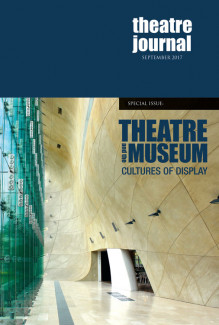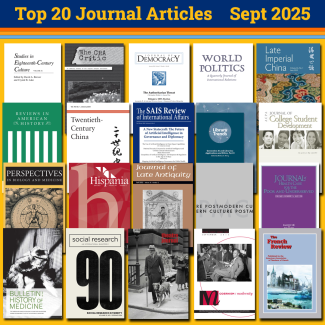
Johns Hopkins UniversityEst. 1876
America’s First Research University
A Night at the Museum Show

Earlier this year, Theatre Journal released a special issue on "Theatre and the Museum/Cultures of Display," sparked by journal co-editor Jennifer Parker-Starbuck's personal fascination with the history of collection and display.
"This special issue, then, was initially sparked by a cross-section of my interests; indeed, my essay about taxidermy and performance (generously referenced here in Joshua Williams’s essay) began when I became fixated on an exhibit of taxidermied dog heads circling around the head of a wolf in the Horniman Museum in South East London," she writes in her introduction to the issue.
Parker-Starbuck joined us in a Q&A to talk about the resulting five essays and how the topic makes a natural connection to the theatre performance.

How fun was it to work on an issue that developed from the intersection of your personal interests?
This Special Issue came about because not only was I brought up going to museums (from my mother’s love of art, to living outside of Washington, D.C. when I was young, where the free entry Smithsonian Museums provided hours of amusement) but also because my own research on the non-human and performance has taken me toward displays of taxidermy as well as Cabinets of Curiosity. Museums and cultures of display are related to theatre and performance, and it was exciting to think about how scholars in the field might interpret this intersection.
What did you learn from putting together this issue?
I was surprised by the range of material we got in terms of the submissions, and disappointed I couldn’t publish more of it, actually! As I mention in my Editorial Comment, we ended up with essays covering performance in the museum as well as essays interrogating colonial legacies within museums, the acquisition of museum objects, and the performance of the museum itself--addressing questions of curatorial strategies and programming. I learned that this is a growing area of interest and study, and I believe that there will be more scholarship to come investigating how museums and performance work in tandem.
How important is it take a fresh look at things, like viewing museum studies through the lens of theatre and performance?
Of course, this is not a new lens through which to examine theatre and performance, as, for example, Susan Bennett’s 2013 Theatre & Museums attests, but it continues to be a fruitful area for theatre and performance scholars interested in the archive, curation, performing objects, and interdisciplinarity. In the current climate of absurd claims around “fake news,” it is critical that we remain attuned to the histories that have come before us, and to how information is presented. Questioning and challenging how histories are performed and written is one of the jobs of performance scholars and so investigating theatre and museums seems a relevant and timely project.
How important was the freedom to use the journal's new online platform for this issue?
We are delighted with the shape and role of the online platform and hope to see it continue to grow in new ways. For this issue it was also a crucial element for one of our essays, Matthew Isaac Cohen’s “Wayang in Museums: The Reverse Repatriation of Javanese Puppets.” Cohen had a fantastic collection of images taken across his research and the online platform became an opportunity to include many more of them that we’d have been able to in the print version. He created a separate photo essay that works in conjunction with the printed essay or independently on its own. More importantly, it allowed many of the people mentioned in Cohen’s research to have access to the online photo essay when they might not have access to the paid journal site. The online platform thus provides an expansive access to a larger readership.
What do you hope people do with the topics raised in this issue?
My hope is that readers might see museums through a more multi-faceted lens through some of this research. It might, perhaps, shine a light for readers on the non-interrogated Colonial histories still present in many museums or to new curatorial strategies being used for displaying some of the more problematic content; the essays may allow readers to look for programming of different modes of performance and performers in their local museums; this issue might be an impetus for readers to think of the museums they know in terms of how the museum itself relates to its site, surrounding cultures, or contents. My hope too is that the essays inspire people to think about how the objects within museums have a life and have emerged from lives and histories and specific moments and cultures so we can better understand how these lives continue to “perform” through history.


